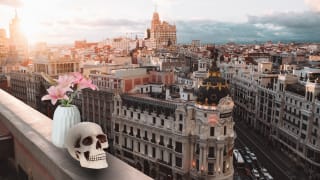How a rural destination made a big impact with a small budget
Rural destinations are facing a potential renaissance. Agriculture has often been – unfairly – viewed as either ‘wantonly industrial or quaintly old-fashioned.’ However, a new wave of innovation in the field, alongside a strong quality of life proposition, is challenging these stereotypes and creating new opportunities for rural destinations to stand up and attract attention to their communities.
Portugal’s Idanha-a-Nova is one such region that is leveraging assets to position itself as a hub for agritech and rural innovation, and inviting prospective residents to experience the region’s quality of life proposition first-hand. Mayor Armindo Jacinto sat down with us to explain how a clear place brand strategy overturned decades of population decline and positioned the region as a place of opportunity and prosperity.
“Rural” is not often associated with perceptions of innovation and forward-thinking – how has Idanha-a-Nova countered misconceptions and established a future-facing brand?
Idanha is a place where everyone can aspire to start again, surrounded by nature – that’s our motto!
Innovation in technologies, products and services is the key to achieving sustainable development in rural areas. It becomes a tool for social and economic transformation, especially when combined with an exceptionally rich and diverse natural and cultural heritage.
This is the path we believe in – to show rural societies in a modern and innovative way. A real life alternative. An opportunity for investors, generating economic growth and new jobs, in a unique and specialized manner.
Therefore, the Municipality of Idanha-a-Nova joined forces with Bloom Consulting and, together, we developed a branding strategy that shines a new light on rurality and rural life.
Promoting rural and ecological entrepreneurship is a priority for Idanha-a-Nova, as demonstrated by the ‘Idanha Green Valley’ program, which is a part of the ‘Restart in Idanha’ strategy. The main goal of this program is to create a global brand recognition for Idanha as a green ‘Silicon Valley’. To show that our rurality can offer opportunities and a fantastic quality of life for investors, businesses and talent that prioritize sustainability, nature and innovation, particularly in the food system and the green economy.
We know that Idanha is a small place in Europe - not in geographic terms, but in the number of people who live here. Nevertheless, these territories play an important role, for example, in tackling climate change.
‘Restart in Idanha’ has clearly been very successful for the region. What impact has it had for your citizens?
The ‘Recomeçar / Restart in Idanha’ strategy was publicly presented in 2015 and has been ongoing since then. It was created to respond to a major problem, a problem that most of the territories in the Portuguese interior can identify with: the exodus from rural areas to the big cities. To give you some context, Idanha had lost about 70% of its population, dropping from 35,000 residents to about 8,000 in just 50 years.
Consequently, the main objective of our brand strategy was to invert our migration balance. And we did it. Since 2019 we have a positive net migration. In other words, today more people are arriving than leaving. It is a great step to gaining population in the territory.
We have been successful in fighting negative rural perceptions and positioning Idanha as a place of opportunity - so much so that Idanha received the “Star Municipality” Award for small municipalities in Portugal in 2022. Among towns with less than 10,000 inhabitants, Idanha grew the most - in tourism, business and quality of life.
Part of Idanha-a-Nova’s strategy was to invite people to experience Idanha before they re-located. How did that work in practice?
‘Idanha Try’ is one of the “Restart in Idanha”’s four strategic programmes. It enables those who are considering moving to the municipality to try out country living. It includes projects that foster integration and participation in the local community. People can come to our events (that are mostly free), network with investors, visit the farms or our schools and other facilities and discover destinations within the territory, staying at local accommodations. You can follow us at www.idanha.pt.
Since the start of the pandemic, we’ve seen a trend of people moving away from cities in search of green space and greater quality of life. Is this a trend that you’ve observed as well? What steps do you have planned to build on this energy?
Idanha-a-Nova has created solid foundations to make our development strategy possible and sustainable. It has proudly affirmed its rurality by positioning itself as a centre for knowledge and innovation, using it as a front for progress, entrepreneurship and social and economic development.
We are building coworking spaces for digital nomads exploring the world and other people that like to be connected with nature.
We also have a Local Centre of Migrants’ Integration Support that aims to provide, to the citizens/migrants, articulated local responses regarding their welcoming and integration needs.
We have the lowest tax burden possible to citizens and businesses and we can help entrepreneurs to launch their businesses.
It is all part of the strategy to attract talent looking for a new lifestyle, living in a rural area surrounded by nature.
How are you leveraging your sectoral strengths in agritech to attract more investment?
A bit of context: ‘Restart’ has four strategic programmes. ‘Idanha Try’ is one of them, as I mentioned before. ‘Idanha Live’ is focused on creating the best life conditions possible. This way, we can maintain our residents and really attract new people wanting to move to a rural environment with ease.
‘Idanha Green Valley’ aims to create a global brand recognition for Idanha-a-Nova as a green “Silicon Valley”. It focuses on knowledge and technology, especially in agritech. It serves as an incubator for talent and ideas, supporting and creating innovative projects and strengthening local businesses.
Finally, ‘Made in Idanha’ intends to show the world the great things we do in Idanha. It gathers all the institutional and promotional projects that aim to put Idanha-a-Nova on the map. From the awareness of citizens and sharing of knowledge and traditions of Idanha to creating and engaging in networks in the fields of culture, agritech, and tourism.
What’s the secret to making an impact with a place branding strategy on a smaller budget?
Idanha-a-Nova is a largely rural municipality with 1,416 km2 and less than 9,000 inhabitants. Located in central interior Portugal on the border with Spain, it holds a unique historical and cultural heritage.
That said, we believe that our rurality does not have to represent a setback. It can and should be an opportunity for us to build a cohesive, inclusive community, prepared for future challenges. A society of this kind needs to be open to initiative, innovation, and economic and social progress.
Therefore, our vision focuses on innovation, creativity, and sustainability. We always try to understand and communicate clearly and coherently the attributes that make Idanha unique: our cultural heritage, our landscapes, our people.
As I mentioned before, the results show that we are on the right track.
What’s next?
I believe that cooperation and networking are crucial for a place marketing strategy that promotes a strong brand and its effective communication.
We will continue to seek a development strategy that both promotes and benefits from a collaborative approach. This can boost and enrich the strategy’s impact at national and international levels.
Right now, we are working with Bloom Consulting on building a new united place brand in Portugal. Five municipalities adjacent to the Spanish border working together on creating a place brand for rural innovation: Almeida, Figueira de Castelo Rodrigo, Idanha-a-Nova, Penamacor and Sabugal. A place brand capable of portraying the innovative Portuguese rural world, with a vast area and potential, with open doors to Europe.
We believe that a bigger place brand will expand the ability to attract investment and new innovative companies to the territory.
It is a five way shared vision. A vision that the rural world and the countryside can be attractive. Our goal is to inspire a modern and innovative rurality, capable of attracting families and businesses.









